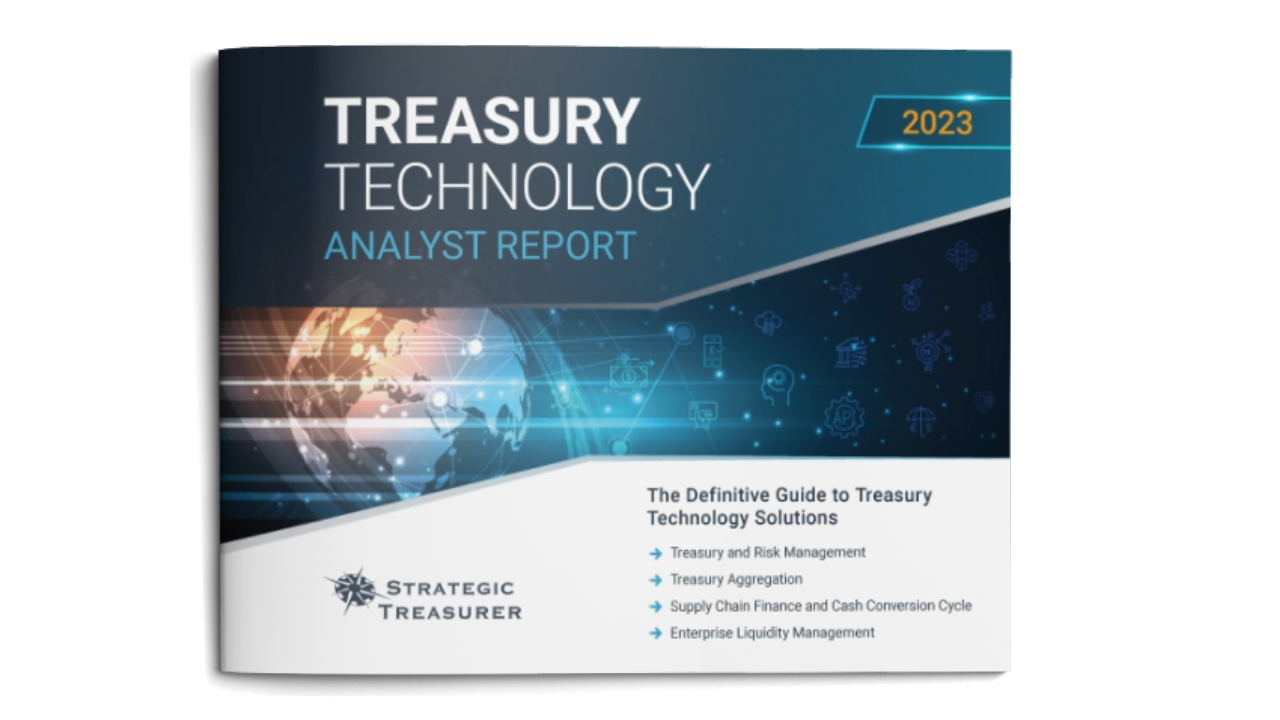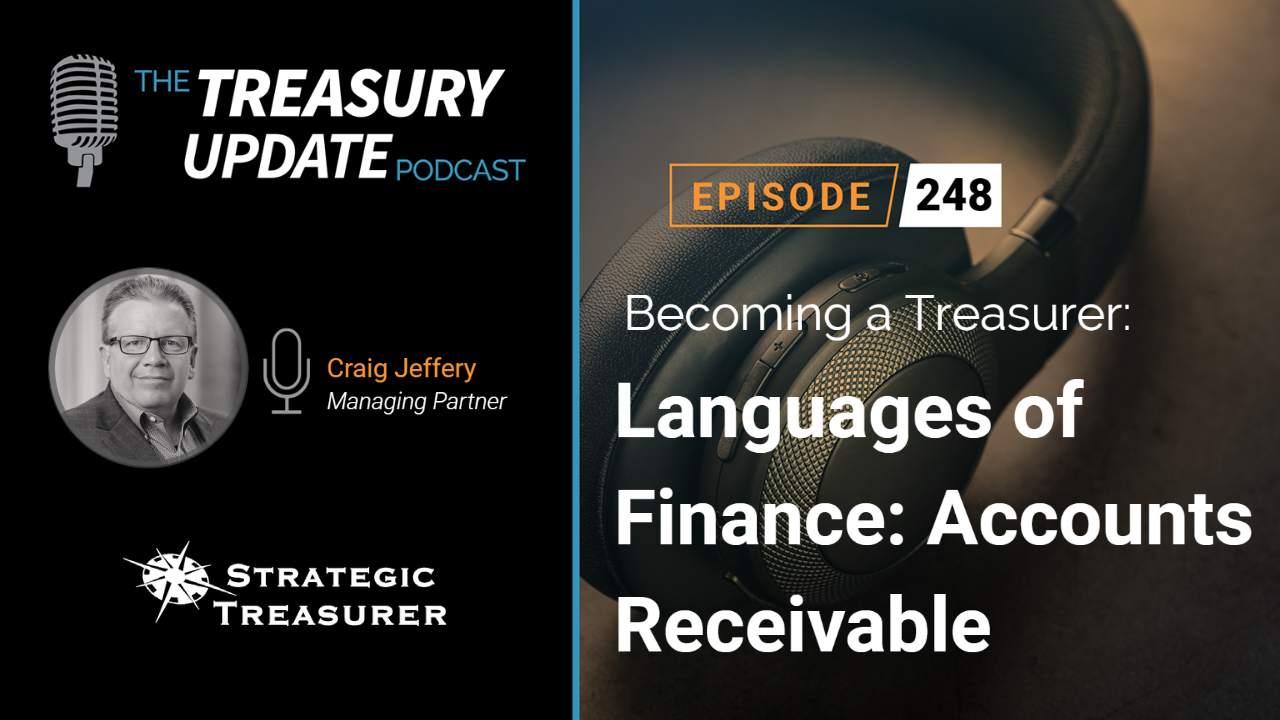
Episode 279
Short-Term Investing Series by Federated Hermes – Part 1: Money Market Reforms
In this episode of the Short-Term Investing Series with Federated Hermes on the Treasury Update Podcast, experts from Federated Hermes discuss the 2023 money market reforms. They explain the key changes in liquidity requirements and how they impact government and prime money market funds. The conversation also touches on the evolving interest rate environment. If you’re in the finance industry, this podcast episode provides insights to help you navigate these reforms with confidence.
Speakers:
- Craig Jeffery, Managing Partner at Strategic Treasurer
- Deborah Cunningham, CFA – Chief Investment Officer, Global Liquidity Markets, Senior Portfolio Manager, Executive Vice President, Federated Investment Management Company
- Susan Hill, CFA – Head of Government Liquidity Group, Senior Portfolio Manager, Senior Vice President, Federated Investment Management Company
- John Mosko – Senior Vice President, Liquidity Management Division, Federated Securities Corp.
Visit federatedhermes.com for more information.
Speaker:
Deborah Cunningham, Federated Hermes
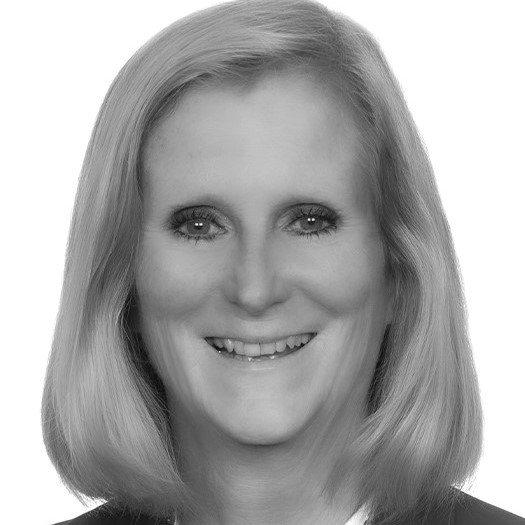

Speaker:
Susan Hill, Federated Hermes
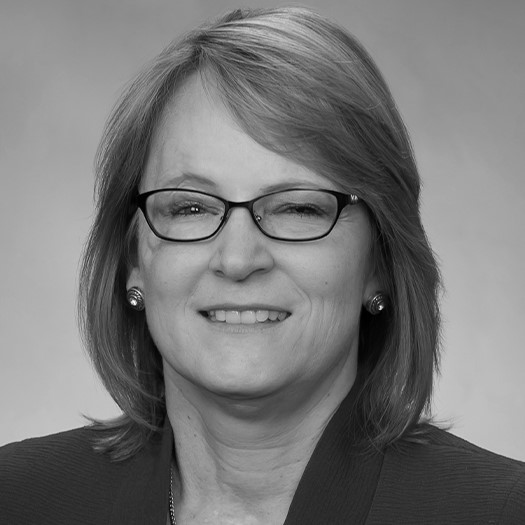

Co-host:
John Mosko, Federated Hermes
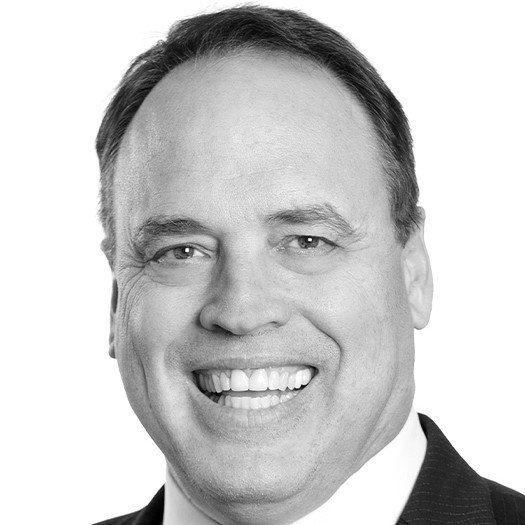

Co-host:
Craig Jeffery, Strategic Treasurer


Subscribe to the Treasury Update Podcast on your favorite app!
Episode Transcription - Episode # 279: Short-Term Investing Series by Federated Hermes - Part 1: Money Market Reforms
Announcer
Welcome to the Treasury Update Podcast presented by Strategic Treasurer, your source for interesting treasury news, analysis, and insights in your car, at the gym, or wherever you decide to tune in.
Craig Jeffery
Welcome to the Short-Term Investing Series by Federated Hermes on the Treasury Update Podcast. The series is brought to you by Federated Hermes and more information about Federated can be found at federatedhermes.com. In today’s episode, we are covering money market reforms, with a focus on short-term investing implications. A new set of money market reforms, 2023 reforms, were put forth in large measure to address some of the shortfalls or unintended consequences realized after reforms were put in place in 2010 and 2014. During 2020, many money market funds experienced heavy churn as we entered the COVID era, resulting in an action by the Fed to create a liquidity facility to support these funds. The interest rate environment has changed substantially over the past 18 months, and additional volatility seems inevitable. In addition to inflation, triggering central bank actions and global unrest, recent regulatory changes have created a new set of money market reforms. This session will help get treasurer’s current on the interest rate environment and the investment vehicle used by treasures. These include money market funds, separately managed accounts, private funds, and we’ll cover 2023 money market fund reforms and their implications on short term investing. With $715 billion in assets, Federated Hermes sits among the global leaders in investment management. Its financial offerings span asset class and product type. Cash management is a core business for many decades, and the firm has been a pioneer and innovator. 2024 marks the 50th anniversary of its first money fund offering. Today, a multitude of investors of all sizes and types entrust Federated Hermes with managing their liquidity needs. It offers an extensive menu of targeted solutions, including prime government and tax free money funds tailored for individuals and institutions across the spectrum of risk budgets and investment horizons. Welcome to the Treasury Update Podcast. I’m Craig Jeffery. Today’s episode has a co-host, John Mosko, who’s Senior Vice President of Liquidity Management Division at Federated Securities Corporation. And we’re joined by two guests also from Federated Investment Management Company, Deborah Cunningham, who’s the Chief Investment Officer of Global Liquidities Markets, and a Senior Portfolio Manager along with being an Executive Vice President of the firm. And Susan Hill, Head of the Government Liquidity Group, a Senior Portfolio Manager and Senior Vice President, also at Federated Investment Management Company. Welcome to the podcast John, Deborah, and Susan.
Deborah Cunningham
Great to be here today. Thanks.
Susan Hill
Yeah. Thanks for having us.
John Mosko
Hey, Craig, good to be here.
Craig Jeffery
I’m so excited about this series. And John, I’m happy to have another co host to talk us through these topics. Alright, so let’s let’s begin. Debbie, maybe we can start with you. The context of money market reform, maybe you can talk about the 2008 situation, what happened there, and then some of the reforms that came about in 2010 and 2014. What happened then, and what’s the purpose, just for background?
Deborah Cunningham
Sure, I’d be happy to give you that background. So throughout the spring and the summer of 2008, there seemed to be basically a financial event every weekend that caused the financial markets to open every Monday with more concerns with higher spreads and with less liquidity, the theme of the stress centered around the subprime mortgage market and its deterioration. And it impacted structured finance, it impacted broker dealers, US and global banks, government sponsored entities like Fannie and Freddie, and insurers. And note I did not say money market funds included in there. It culminated, however, in September 2008, with the failure of Lehman Brothers. One US money market fund, enter the money market funds into it, in particular, who owned the debt of the failed investment bank was unable to maintain its $1 stable net asset value, and as such it had to gate its fund to not allow for shareholder redemptions. This caused widespread shareholder concern for all non government money market funds basically in the industry, and a subsequent decline in assets of about 20% occurred. These events spawned the 2010 and 2014 reforms to Rule 2a-7, and that’s the rule which governs how money market funds are able to get invested. The most important changes that occurred in 2010 were for the requirements of a minimum daily liquid amount of assets of 10% and weekly liquid assets of 30%. For the 2014, reform changes were more draconian. These included linking the potential for charging a fee or for gating a fund to that weekly liquid assets number, and requiring a floating net asset value for institutional non-government money market funds. The result of this was a drastic shift in the money market asset base, leaving the non-government sectors and going into the government sectors.
Craig Jeffery
Debbie, thanks for that background. It’s it’s a good refresher and a hard refresher at the same time. For the people who are listening in, maybe we could have a quick introduction of each person and your role at Federated Hermes. Let’s go Debbie, Sue, and then John.
Deborah Cunningham
Sure. So I’m Deborah Cunningham, Executive Vice President, Senior Portfolio Manager for our liquidity products at Federated Hermes. I am an MBA and a CFA. I’ve been working in the liquidity management business my entire career. We currently manage here at Federated Hermes 525 billion in our liquidity group in all major segments. This includes government, prime, and tax free money market funds. We operate products in the US as well as offshore, and in three different currencies: dollars, sterling, and euros. We advocate to our clients that we’re innovative yet we’re conservative.
Craig Jeffery
That’s a few years. Thanks. Thanks, Debbie. And I, I can’t I know I’ve heard you so many different times addressing the space on money market funds and investments. Sue, would you give us a quick intro?
John Mosko
Happy to. Thanks, Craig. So I’m Susan Hill. I’m a Senior Vice President and Senior Portfolio Manager Head of Government Liquidity at Federated Hermes and manage Federated’s government liquidity products. They approximate about $325 billion today, in a combination of 2a-7 money market portfolios, local government investment pools, and other types, in other investment types. Like Debbie, I am a seasoned veteran of Federated Hermes, I joined the firm in 1990. I have more than a few scars from various financial crises. My first job actually right out of college was with the US US Treasury Department in their office of debt management. I am also an MBA and a CFA.
Craig Jeffery
Excellent, thank you so much, Sue. And John, who’s also co hosting. But go ahead, John.
John Mosko
Thank you, Craig, John Mosko, Senior Vice President in the Liquidity Management Division for Federated Hermes. I have a dual role. I cover the Mid-Atlantic for Federated Hermes in the liquidity management products. I also oversee our institutional sales group. And those clients include corporate practitioners of all types, corporations, higher ed, foundations, endowments, public entities, certain public entities, and how they trade through portals or intermediaries, our bank partners. We have relationships with the largest trust banks and some, obviously, broker dealers. Not unlike Debbie and Sue, I started in this industry in the last century, and I’ve spent my entire career in the in the front end of the curve in the money market business.
Craig Jeffery
Excellent last century. Last millennium too, right? That’s awesome. Well, John, you’re also you’re also co-host today. So why don’t why don’t you take it away as we move into the period of COVID and money market reform?
John Mosko
Yeah, so thanks, Craig. And so and Debbie, thanks for that pretext as how we got to this point in the money fund timeline. And we thought everything was kind of working smoothly, rates were behaving reasonably normal. And then unfortunately, we were hit with the COVID virus, and its effects, subsequent lock downs and the concerns in the marketplace. And so Sue, you were sitting there on the desk. And when we started to stay home for 90 days and do nothing, kind of walkthrough first, what happened, I guess, is probably the best way to talk about it. Then your relationship with both our friends in the industry and the Fed, how’d it feel? What it feel like? Yeah, let me take a trip back in time for a bit. So March of 2020 was really just such a surreal time, you know, for for so many reasons. We were all in the process of picking our stuff up from the office, figuring out what equipment we needed or could steal from our co workers, you know, and saying kind of these naive things like, hey, we’ll see you next week or next month. We didn’t realize we’d probably be more like next next year. And meanwhile, of course, the the financial markets were really in disarray and in crisis. And this time not from the credit forces that Debbie described in 2008. But more for from liquidity concerns. The equity market began struggling even before March. The S&P 500 peaked at just over 3300 in mid-February before declining precipitously to 2200 by the third week of March. The bond market exhibited some pretty extreme volatility, particularly for Treasury securities, those safe haven investments, the place where investors tend to flee during times of trouble. And initially that’s really just what happened. In response to the equity market declines, we did see, in response to concerns over growth as the world shut down, we saw yields on the 10-year Treasury fall from 1.6%, in the middle of February to what I think is an all time low of just 0.3% in overnight trading at some point in early March. And we weren’t concerned with like our repo counterparties, or bank credits, or it wasn’t, you know, unlike 08, 09, it wasn’t like, we didn’t look at our book and say, We have to watch out for something. It was just more liquidity than just about anything else. Yeah, it was it was more liquidity than than anything else. At that particular time we didn’t really have concerns in the market, we’re just trying to get a get a sense as to what all was taking place. Investors, though, at large really became as you know, laser focused on liquidity, on having access to their cash, on building cash positions that they needed, or they might need just in case. And so in a mad rush, you had investors starting to take their money out of longer term investments. Again, not a front end phenomenon at all, but but out the yield curve, it became really, really quite striking. Asset managers were forced to sell those Treasuries, those liquid holdings of Treasuries to raise cash that drove Treasuries, again, focusing on that 10-year Treasury yield, precipitously higher than up back over 1% really in a matter of days. As you know, John, you know, the liquidity in the market from a trading perspective is viewed in terms of looking at the bid ask spread. So, you know, what you want to get paid versus what what your your dealer counterparty is willing to pay you. And spreads on Treasuries went from just a couple of basis points in normal times, that bid ask spread went out to 30 to 40 basis points at some point. So really, in short, that the most liquid market in the world was seizing up, and as were sovereign markets across the globe. But at the front ends, you know, things became strained, eventually became strained. That global dash for cash really pushed yields on short term treasury bills downwards, toward zero as one would expect, but fear and that overwhelming need to build cash, and for other precautionary reasons led to redemptions from certain types of money market funds, institutional prime money market funds, in particular, in what was just a more general seizing up of the commercial paper market and other short term investments. I think at this point, the flaws in our previous wave of money fund reform, you know, became clear, investors became concerned that their assets would be gated in funds, as liquidity positions were restrained. We do tend to think, and John, I know you and I talk quite a bit about the Fed and the role of the Fed. We do tend to think of the role of the Fed as being one of monetary authority. So that dual mandates, right? The price stability and full employment in a part of things, but the Fed also has the responsibility of maintaining functioning capital markets, right? And they responded to that really rapid escalation of financial market strains quickly and forcefully. They, of course, unfortunately, lowered the policy rate down to zero, where we almost in a heartbeat by the middle part of March. They embarked on quantitative easing, which we’ve seen before. And then they brought forth a whole host of emergency facilities. And this is where the interaction that we have on a regular basis with, you know, regulators and the Treasury Department, and others comes into play. But those emergency facilities there’s just a laundry, you know, laundry list of them. They pulled out their playbook from 2008, they announced a commercial paper funding facility, a primary dealer, credit facility, the money market fund liquidity facility, and probably about, you know, a handful of others that I can continue to mention here. But I did want to focus on those two money market facilities. One, the commercial paper facility that supported the money markets at that time, and then the money market liquidity facility, and those were intended to calm things at the front end of the market. And really, it was the announcement of the facilities that did the most good. Their usage to give money fund managers or commercial paper investors a place to go to raise cash, their usage ended up really being quite small. But the announcement and the forceful action from the Fed I think was, you know, was what made the most difference. So we’ve talked through COVID, we’ve talked through the liquidity concerns in the market, of course, you know, that has opened the door to our latest wave of money market fund reform. Yeah, so if we could take just a slight detour, because you did mention the commercial paper facility. You know, I think, Debbie, one of the things, and we don’t want to blame technology, if you will, but I, you know, because it’s creating the environment that we have right now: podcasts, webinars, various types of messaging systems where we can see and talk to one another. But, you know, the rules that were in place, as of 21 of them, that people invested in prime money market funds were watching those weekly liquidity numbers. And is it safe to say that there was a cascading effect as a result of people monitoring the weekly liquidity numbers in prime money market funds?
Deborah Cunningham
Absolutely. It was one that nobody wanted to be near 30%, so although it was designed as a measure of liquidity protection for money market funds back when it was implemented in the 2010 amendments, it in effect became unusable. So firms would set their own levels, maybe when a fund passed through 35%, or 34%, or 32%, they would liquidate, and ultimately, it had a self-fulfilling end result, which was funds going lower and having to continuously find other ways of increasing that liquidity within the portfolios, but never ever using it to the tune of 30%. Because it was there as a cushion, not for user capabilities.
John Mosko
Yeah, I mean, so sadly, you put rules in place which you think are helping and creating and avoiding first mover advantage. Just move the needle a little higher.
Deborah Cunningham
It was a cliff. There was a cliff and, you know, the cliff differed a little bit depending upon individual shops and where they where they set it. But it was certainly noticeable and, you know, what was happening in the marketplace at that point, especially on the institutional side. Not as much prime retail, definitely prime institutional.
John Mosko
No, because it’s important to reiterate, it was not a credit event. We weren’t, you and your team did not have, for lack of a better word, did not lose a minute of sleep thinking about the individual credits inside the portfolio, it was more.
Deborah Cunningham
That’s right. And then the financial crisis of 2008, in addition to what I said, also required us for the prime in the muni markets to separate institutional and retail. And so institutional was not doing anything to harm retail. Retail was in and of itself altogether. It was institutional versus institutional.
John Mosko
Right, we did many calls with, you know, from the from the clients in our retail book, and it was very apparent that once they understood it was not a credit event, they became they stayed comfortable in the in the product. And you know, as a result has been, as rates have gone up, a tremendous success story. So that now leads us to where we are today. The SEC felt that there was need to tweak money market mutual funds a little more. So we went through the process, wrote the letters, talk to all the people, liaised with our peers in the industry, and we got to this point where we are now. So Debbie, why don’t you start and talk about the effects to prime, the important dates that investors would want to know about, and what that means in terms of how, to the extent that we know because it’s still sort of in process, what that means for our funds or funds for the industry?
Deborah Cunningham
Absolutely. So there are three main implementation dates for the 2023 2a-7 reforms, the first of which has already passed. And from a prime money market fund standpoint, I’ll talk about prime and then Sue can talk about the government side of the equation for the prime money market funds, the date that’s passed, the October 2 2023 reform implementation date, it was really great news. Two major items came to pass with with that date. Number one was the ability to gate a fund was actually removed. So that was no longer a capability. And then secondly, the linkage of potentially imposing a fee, based on the level of weekly liquid assets was also dropped. Both of those issues were really major concerns to shareholders who were looking to money market funds to provide daily liquidity at par. How could they do that if a gate or a fee was possible? Daily liquidity at par doesn’t equate with gates and fees. As such, the nightly sweeps that have historically gone from distributors into money market funds, distributors of money market funds into prime money funds, now switched to government money market funds, and that would have been back in the 2000 and with the 2014 reform implementation. Now that the consequences of gates and fees have been removed, though, that October 2 2023 date was really a major win for the prime sector, and ultimately should potentially reallow for those sweeps to go back into prime money funds, if investors choose so. The second major date then is the April 2 2024 reform implementation date. And in this one, the biggest impact for money market funds would be to increase their daily and weekly liquid assets from what are currently 10 and 30% requirements, up to 25% for daily and 50% for weekly liquid asset requirements. So from that date forward, April 2 of 2024, at least 50% of the assets in a prime money market fund must be maturing, or otherwise available for use, within seven days. Generally, when you’re looking at the prime curve, we have a positively sloped yield curve, and therefore the very, very short securities, those that are seven days or less and maturity and liquidity, are there for providing liquidity, but not necessarily for the yield. So when you look at a positively sloped curve, the seven day segment is usually negative compared to what we could buy for three months securities or six months securities or a year securities on a spread basis, for instance. So the outcome of those April changes will likely be a slightly lower yield on Prime money market funds, because of that, you know, extra that’s now required. And then a secondary impact for prime funds in April of 2024 will also be for required enhancement to the procedure and process for reviewing whether or not a discretionary liquidity fee might be needed within a fund. And since the prime sector already deals with discretionary potential fees, we really are viewing this as simply an update to those procedures surrounding that decision making, which would bring us you know, in the to the April slot requirements as, you know, sort of a modest win from a prime sector perspective, but with some implications for a little bit less on a yield basis.
John Mosko
Nobody wants to impose a fee, right?
Deborah Cunningham
Nobody wants to impose a fee. It’s already possible, nobody has. Which is, you know, quite frankly, one of the reasons why the SEC gets us to the last implementation date, which is October 2 2024. And it only is pertinent for institutional non government money market funds, they’re the only ones that are being impacted for that. This is also the sector that is the floating net asset value sector pricing to 1/100 of a penny rather than a cent. So in some ways, this is kind of a double whammy to this sector. But for those impacted funds, the institutional non government sector, they represent about 5%, a little less than 5% of the total money fund industry, they will be required to charge a mandatory fee if the net assets decline greater than 5% in any one single day and if the resultant sale of a vertical slice of assets of the fund to cover that sale has more than a one basis point de minimis cost associated with it. So these are pretty big ifs and an and, and in our opinion, they’re highly unlikely and have historically only been potentially valid during markets like September 2008, or March of 2020. Nonetheless, we have to prepare for this. We’re ultimately doing it. And if you look at what they proposed, it’s better than swing pricing would have been. That was the option that was originally proposed. So I guess I characterize the last implementation date October 2, as a mild negative, but only to a very, very small sector of the market. And then I don’t know whether, Sue, if you want to talk about that the government sector, how it’s impacted by each of these changes,
John Mosko
I’m still processing vertical slice, excuse me.
Deborah Cunningham
I know. I tried it. Is it my sandwich? Am I cutting it in half on a vertical, diagonal basis? On a vertical? How am I doing it?
John Mosko
You’re getting crust, some white bread, and some turkey.
Deborah Cunningham
That’s part of the gift.
John Mosko
Government money market funds A little less complicated, don’t you think? We are a simple bunch over here we are in fact. So government funds. The SEC defines what a government money market fund can invest in. It can invest in Treasury securities and agency securities either directly or through repo. They tend to attract assets during times of financial financial turmoil, as was the case in 2008. And again, in the spring of 2020. We buy a lot of treasury bills, we help to finance a lot of longer term treasuries and agencies through a repo market, and therefore, we tend, some apologetically, not to be really the focus of the waves of reform. So the SEC proposed a number of reforms, but they were really mainly two that had direct impact on on government funds. First, in terms of liquidity, we are subject to the higher liquidity requirements. The SEC, as Debbie’s outlined, previously had a 10% and 30%, minimum daily and weekly liquid asset threshold. They’ve raised that to 25% and 50%. Big jumps, but not really much of an impact from my perspective as most of the securities that I invest in qualify from the SEC’s perspective as being either daily or weekly assets. The most meaningful aspect of reform, for me really, was something that I know we all hope we will never see, and that’s a negative interest rate environment and how stable value portfolios, government funds today, government money funds today and retail prime portfolios, what they would have as options if the Fed were in fact to adopt a negative monetary policy stance. In the initial proposal, the SEC intended to permit stable value funds to have only one option, which would be to float their net asset value. But after some reflection and a fair amount of lobbying and arguing on behalf of the industry, they’ve now permitted an additional method of handling a negative interest rate environment called a reverse distribution mechanism. Now, that sounds an awful lot like a vertical slice in terms of how, you know people will understand it, so I won’t go into into great detail. But it’s essentially a mechanism that can be used to allow a fund in a negative rate environment, which we have never seen, and hopefully we never will see, to maintain a stable net asset value, which we think is important to, you know, a large part of our of our investor base. So again, positive from our perspective to allow for more options for an environment that I hope we never see. Yeah, and I know we have to prepare for these things. I think it’s prudent to prepare for this call. But it is a very, you know, seminal event in the marketplace. That said, it’s pretty safe to say what we lived through in 2008 was pretty dark from day to day, you know. As Debbie kind of laid the groundwork, it was every day was another present, if you will, to the market. And we didn’t need negative interest rates, and certainly during COVID there as well. So I can appreciate the regulator’s preparing, but I think from an investor perspective, we’re 6% away from something like that happening.
Deborah Cunningham
I agree completely with that.
John Mosko
Hey, Craig, I want to loop you back in here. I know that you talk to practitioners every day. I know you were quite a positive presence on the AFP floor last week. I think that’s great stuff, the service you provide for your practitioners that we deal with on a day to day basis. So as you talk to them, what are they telling you? Like, are you getting those questions? Are they kind of quizzing you from what other people are thinking about? Because I think at this point, maybe the four of us can kind of kick around like next steps, options, things like that.
Craig Jeffery
Good question. I was definitely enjoying the conversation. I was I wasn’t expecting to hear the diagonal slice comment. I was expecting to hear something like unintended consequences of some of those regulations, but it was it was quite fun to hear you discussing it. So I mean, some of the things that we continue to hear, focus on, you know, the core liquidity concerns on funds and other asset options. There’s, I would say, a small segment that’s focused on counterparty risk across the whole environment. And so how that comes to play into money market funds is still an important piece. But I guess I would say that the whole schedule when things are occurring, if someone’s focused heavily on the investment side, they know the dates and understand what’s going on. I think the big challenge is for those companies where that’s part of something they do, it’s, you know, a fifth of their job. They’re not sure what’s happening, exactly when, or they may have the percentages or changes, understanding what they what they need. The unintended consequences of some of the other reforms I think that has moved it to be less of a concern. What are you hearing, when you’re talking about this multiple times a day?
John Mosko
And then that makes sense that I think as we’re having these conversations, I think the good news is, is that today, it’s business as usual. And there’s time to process the new liquidity requirements, the vertical slice, what that means for yields and NAVs, and I don’t think it’s, it’s, I think we’re in a good space right now, as far as practitioners are, for using money market mutual funds for exactly the utility they’re intended to be.
Deborah Cunningham
I think the higher for longer argument comes in here as well, John. You and Sue talked a little bit about the negative rate environment that we don’t ever think that we’re going to enter. But I don’t think we’re even going back to the zero rate environment. If you had operated in the market over the last 15 years, you might think that zero was the norm, but it’s really not the norm. 3, 4% is the norm when you’re looking at an inflationary environment that’s normalized to 2 or 3%. So 5, 6% yields that we’re seeing today aren’t going to zero. The return from a market perspective is going to continue to be for the safest asset class in the world of cash, pretty respectable, in the in the next year, two years, three years, as long as the Fed is maintaining its current trend and track. And, you know, we don’t see any reason why they would not be at this point.
John Mosko
Like him or not, I think the Fed chairman and the Fed, are trying to return the markets to markets and have less intervention. Obviously, the reverse repo facility is a tremendous monetary policy tool. I think it’s, you know, Sue you can jump in here, less of the Fed funds rate and more of the reverse repo facility, but letting the markets be the markets. Yeah, I agree. I agree completely with that. I mean, I think I think it may take some time to unwind all of the measures that they had to put in place in COVID. But to their credit, you know, they did put it in place quickly, you know, and learned from that 2008 experience as well. So, you know, I think it’s in everyone’s best interest in their own minds to have, you know, functioning markets without, you know, without regulator or other official intervention. And I think we’re moving in that direction. I think more backstop type of facilities, you know, may exist, but will be less than less used as we move forward, It’ll probably help from your perspective to be able to price things normally, without having to say, Well, what happens if the Fed comes in and buys the three month bill? Yeah, no, no, exactly. And I think, it can, we’ve discussed this a number of times internally, you know, the Feds reverse repo facility. So the program they put in place really after the 2008 financial crisis to help them manage, you know, their large balance sheet. You know, we’ve been we and others in the money fund industry have been heavy users of that facility in recent months, and over the last year or so. And I’ve really reconciled, you know, my usage during times of stress because I think it’s consistent with, you know, doing what’s in the best interest of our shareholders and responding appropriately to market conditions. But as we continue to wean ourselves away, I think, you know, I think we’re all in favor of finding alternative types of investments, Treasury securities as an example, to move back to more normal. So I think the big takeaway, Craig, and maybe correct me if I’m wrong, is that, at least for the foreseeable future, meaning the next 12 months or so, practitioners should not be concerned or have to make any outsized preparations for changes in their investment portfolio or from a technology perspective as they answer up to people in the C suite, doesn’t seem that it’s something to be concerned about. Go about their other forms of their business and their job, candidly.
Craig Jeffery
Yeah, that certainly seems to be the case.
John Mosko
So Debbie, any final thoughts on today’s conversation?
Deborah Cunningham
You know, the reforms are very manageable, even positive in some aspects to neutral. And with the Fed outlook and expectations of interest rates being maintained for some period of time, it’s a great, it’s a great place for cash and other types of investments in the money markets at this point.
John Mosko
So yeah, John, I’ll keep it brief. Obviously, I’m going to be agreeing with Debbie that corporate practitioners should feel comfort that money market funds, you know, once the regulations are implemented, have higher liquidity positions, the SEC has undone some of the harm that they did before to the products. We’re really, I think, in a better place going forward. Great. Craig, before I pass it back to you, Debbie, Sue, thank you so much for your time today. And Craig, we’re really thrilled to be partnering with you on this short term investment series on your Treasury Update Podcasts. This is the first of what we hope will be many more, including webcasts. And for listeners here, our website is federatedhermes.com. And you can see our liquidity management center where you can see commentary by both Debbie and Sue as well as other money market reform and money funds 101. Craig, thanks again. I’ll bounce it back to you.
Craig Jeffery
Yeah, thanks so much. Thanks. Each of you for all your comments on this first of a series within the podcast channel. Really appreciate it. And for the listeners, you can see in the show notes the link to the Federated Hermes site to gather more information. Thank you so much for joining us on this episode of the Treasury Update Podcast.
Announcer
You’ve reached the end of another episode of the Treasury Update Podcast. Be sure to follow Strategic Treasurer on LinkedIn. Just search for Strategic Treasurer.
Announcer
Views are as of October 31 2023, and are subject to change based on market conditions and other factors. These views should not be construed as a recommendation for any specific security or sector. You could lose value by investing in a money market fund. Although some market funds seek to preserve the value of your investment at $1 per share, they cannot guarantee they will do so. An investment in money market funds is not a bank account, and is not insured or guaranteed by the Federal Deposit Insurance Corporation or any other government agency. Past performance is no guarantee of future results. Federated Securities Corp. is a distributor of the Federated Hermes Funds and is not affiliated with Strategic Treasurer.
Announcer
This podcast is provided for informational purposes only, and statements made by Strategic Treasurer LLC on this podcast are not intended as legal, business, consulting, or tax advice. For more information, visit and bookmark StrategicTreasurer.com.
Related Resources
- Treasury & Risk Management Systems
- Treasury Aggregators
- Supply Chain Finance & Cash Conversion Cycle Solutions
- Enterprise Liquidity Management
Learn more about these technologies and evaluate some of the top vendors in each industry.




